If you’ve ever driven through a winter storm, you know it can get a little tense. Especially when roads are covered in snow and ice. You might not be able to avoid winter, but you can be ready for it with a set of winter or snow tires, including studded options. We have some tips to help you make the right choice about studded winter tires, how studs keep you in control, and when they can be used in your state.
Studs are lightweight, small metal spikes (studs) that are staggered and inserted across the tread of a winter tire. These studs protrude slightly from the rubber tread surface, helping break through packed snow and ice-covered roads to give you better traction. Note: Extra tread depth is needed to accommodate studs, so studded tire size options are often limited.
A good set of tires is essential for winter driving, whatever the weather. If you’re heading into snow and ice, studded tires can have a big impact on your safety. A vehicle equipped with winter traction tires can stop faster on ice than a car without those tires — even if you’re driving just 15 miles per hour.
Studded tires work best on snow and ice-covered roads that have yet to be fully plowed. As the studs pierce the ice and snow, they provide extra traction to keep you safe and in control.
Snow tires, and especially studded winter tires, are specifically designed to help you stay on the road in snow zones or mountain regions where the temperature regularly drops below 40 degrees. Snow tires are distinguished by a mountain snowflake symbol on the sidewall of the tire. This indicator means the tires have been tested and proven for snow, ice, and slush.
The benefits of snow tires include improved traction, vehicle handling, and skid control thanks to deeper, wider, and more jagged tread than regular tires. This tread allows the tire to pick up snow and maintain traction. The studs on some of those tires give them added grip on snow and ice.
This tread allows the tire to pick up snow and maintain traction. The studs on some of those tires give them added grip on snow and ice.
Studded tires are not always the best option for safe winter driving. Studded tires provide optimal traction on ice or packed snow. But studless winter tires work well on slush and packed snow thanks to wide, deep grooves in the tread and lots of irregular surfaces with sharp edges. These allow the rubber to cut through the snow and grip the road.
As temperatures steadily rise, it’s time to replace your winter tires with all-season or performance tires. We recommend swapping back when you do not plan to drive on snow or ice-covered roads, or when nighttime temperatures are consistently 50º F. As temperatures rise, the special rubber compound found in winter tires can wear out much faster.
Les Schwab Tip: If your winter tires have studs, your state has specific dates those tires must be removed from your vehicle. Find your state’s information here.
Find your state’s information here.
Les Schwab can help you choose the right winter tires for where you drive, including a good knowledge of local state laws.
Winter tires are designed to provide extra traction and control on snow and ice. The differences between studded and studless winter tires go beyond tiny metal studs.
Studless snow tires offer great traction for most winter conditions without the metal spikes. Wide, deep grooves in the tread help keep you in control.
Studded tires have spikes or studs that break through packed snow and ice for added traction.
If you do choose a set of studded winter tires for your vehicle, remember there are state-by-state laws regulating when and where you can use them. U.S. states that do allow studded snow tires permit their use from mid-winter to early spring. Driving outside specified dates can carry a steep fine along with plenty of disapproving looks from your fellow drivers.
Driving outside specified dates can carry a steep fine along with plenty of disapproving looks from your fellow drivers.
Studded tire use is regulated by each state. Driving with studded tires on clear roads not only wears down your studs, it can also decrease stopping distance. That’s because your tread is not making optimal contact with the road — your studs are.
For legal stud dates in your region, check out this state-by-state list of studded tire regulations as reported by the U.S. Tire Manufacturers Association.
The price for a set of studded winter tires depends on the size of tire you need for your vehicle, the features of those tires, the warranty, as well as other options. The experts at Les Schwab can help you choose the right winter tires for your car or truck.
Depending on where you drive and the winter conditions you face, studded winter tires could add safety to outings in tough winter conditions.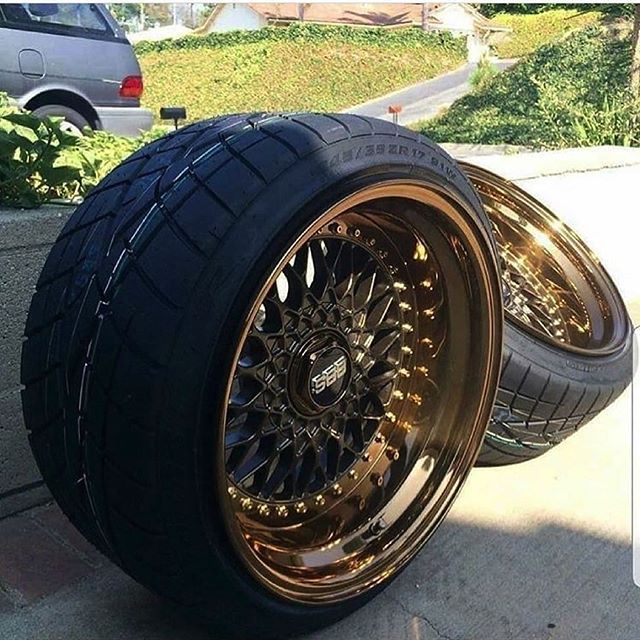 Studded or regular winter tires could be a good choice if you’re a winter sport enthusiast, often navigate unmaintained winter roads, or if you plan to drive in the snow and ice every week. The pros at Les Schwab can help you face winter with the right tires.
Studded or regular winter tires could be a good choice if you’re a winter sport enthusiast, often navigate unmaintained winter roads, or if you plan to drive in the snow and ice every week. The pros at Les Schwab can help you face winter with the right tires.
The right set of winter tires can be found at your local Les Schwab. Stop by today or schedule an appointment and we’ll help you decide on the best winter traction to keep you in control and safely on the road.
Picking the perfect winter tire set can be a lengthy process. You need to know the answers to a couple of questions like what winter conditions you will be driving in or what is the state traction law regarding winter tires, even before your hunt begins.
It is important to purchase the correct winter tire set! These tires are designed to ensure your driving safety in the colder months.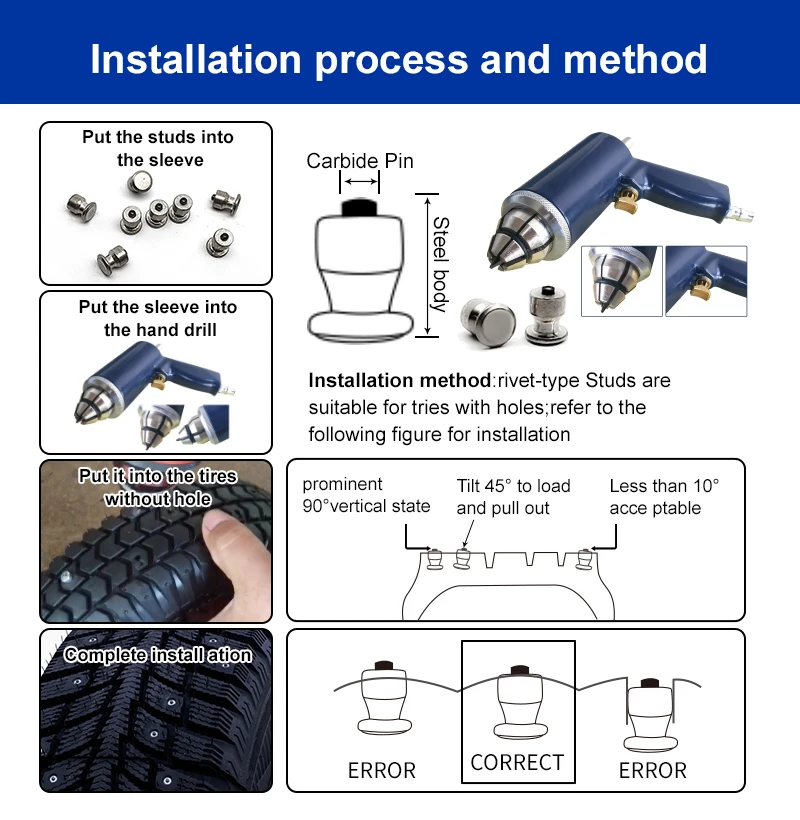 Therefore, what tires you get will differ depending on a couple of factors.
Therefore, what tires you get will differ depending on a couple of factors.
But, what is the difference between studded tires, studdable winter tires, and studless tire sets?
Let's find out the answer together!
Studded tires are a special type of winter tire, which features protrusions along their tread area. These small bulges are strategically placed on the tread area to increase traction on snow and ice surfaces.
Studded snow tires offer better grip, as studs clawing at the ice- and snow-covered surfaces generate additional biting edges. This significantly enhances their traction in winter conditions.
But, what are studs for tires?
Studdable winter tires use hard rubber studs or metal studs to further increase their winter weather performance. Studs are inserted into the pinned tread area, in order to generate additional biting edges.
Studs feature larger diameter cylindrical ends that have their roots inside the tread.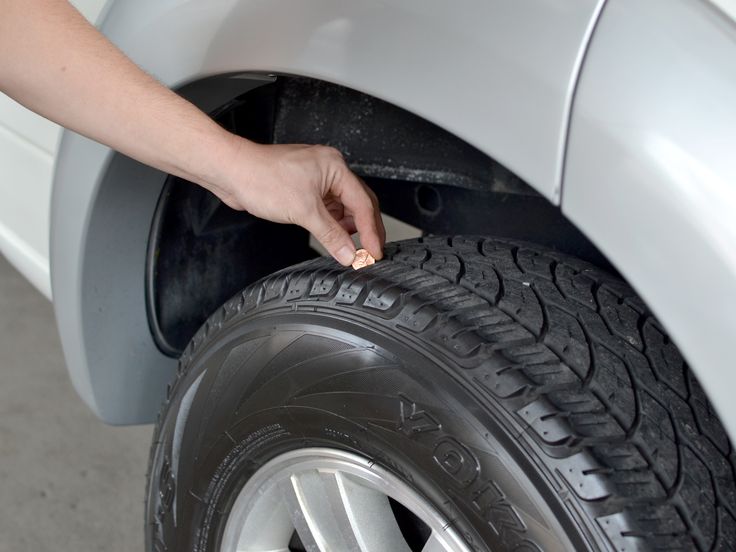 Their top sports specially designed pins, that are taller than the footprint. You can purchase metal studs as well we hard rubber studs for tires.
Their top sports specially designed pins, that are taller than the footprint. You can purchase metal studs as well we hard rubber studs for tires.
Metal studs size chart:
Studdable winter tires are between studded and studless tires. They are sold with pinned tread areas, where studs can be inserted. Studdable snow tires are designed for versatile winter conditions.
You can add or remove studs from the tread area of studdable winter tires. However, doing it too often will damage the tire tread's integrity. Used tires cannot be studded to ensure their driving safety.
Yet, there are new tire technology methods to stud, which have created removable tire studs that help to regulate winter weather performance.
Still, studdable winter tires allow drivers to make decisions for themselves about whether they want to stud their tires or not. While studding tires is a time-consuming process, keep in mind that you will need specific tire stud sizes for specific tire models.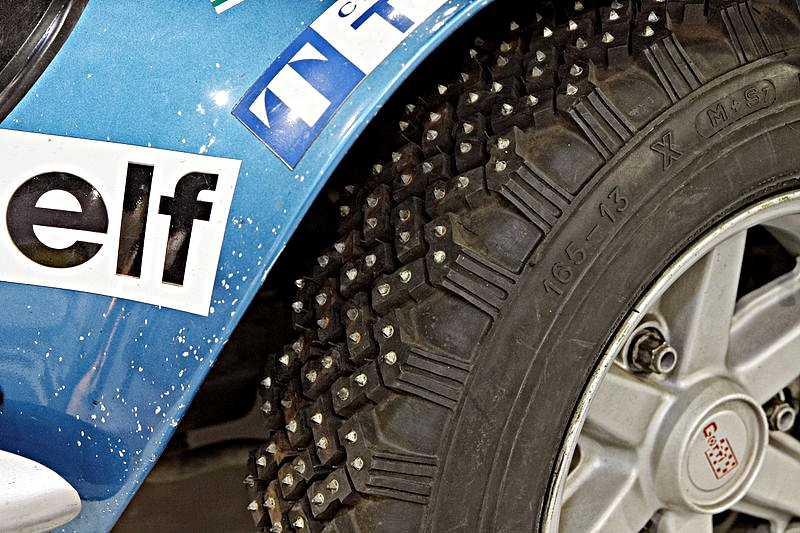
It can happen that you will need to remove snow tire studs. When this happens, this is what you need to do:
Removing tire studs is not too difficult, but it is a timely process. You will need tire lubricant and a pair of pliers. Make sure the lubricant is safe to use for tires and that it does not damage its compound or tread area. Lubricate the studs on an inflated tire, and use the pliers to remove the studs by twisting them.
If you do not have time for this lengthy activity, you can also take your vehicle to a tire shop to have these car studs removed.
Compared to non-studded winter tires, studded tires offer a better grip on snow and ice. But, how exactly do winter tire studs work?
Studded tires provide extra grip during winter driving. Tire studs increase traction on icy and packed snow roads. This is due to the car studs gripping the driving surface, by breaking the top layer of ice.
Furthermore, the car weight helps winter tire studs installed on the tread area to increase traction as the tires rotate. This is something studded tires cannot provide.
However, this piercing ability is what makes studded tire laws necessary. But, we will talk about that later.
When it comes to the studded vs studless winter tires debate, it is important to what advantages these tires offer. Purchasing a specific winter tire set for your needs is crucial to ensure your driving safety.
But, what do these winter tires offer? Let's take a closer look!
Studded tires were specifically designed for harsh winter conditions. Tires with metal studs are able to grip snow and ice-covered roads better, ensuring their forward motion and performance without slipping.
Snow tires with spikes provide superb traction on ice-covered hillside surfaces. Ice studs for tires guarantee the tire's performance even on uneven and unpaved roads. Unfortunately, studless winter tire sets are unable to provide the same.
Ice studs for tires guarantee the tire's performance even on uneven and unpaved roads. Unfortunately, studless winter tire sets are unable to provide the same.
You might also wonder how to get better traction in snow. Well, the answer is also studs, as long as we are talking about off-road surfaces. Packed snow can be easily conquered by studded tires, just make sure you follow state traction laws.
Studless winter tires provide better traction on paved road surfaces. While they do not offer much help on hard-packed snowy surfaces, they conquer cold weather conditions.
The detailed tread pattern of studless tires creates the necessary number of biting edges in order to increase its winter performance. Using studded tires on paved roads can damage roads easily, and for this reason, their use is highly regulated.
Thanks to the wide groove pattern of studless snow tires, hydroplaning is also minimized.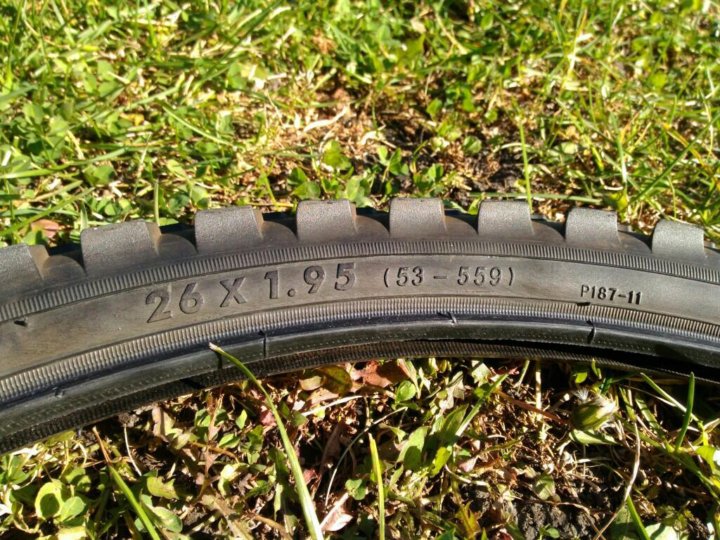 These tires are able to channel water and slush from below the footprint, to further ensure driving safety.
These tires are able to channel water and slush from below the footprint, to further ensure driving safety.
When it comes to the studded tires vs snow tires debate, which tire set works for you greatly depends on where you live.
The question isn't a simple "when do studded tires need to come off?", it's more complicated than that. The use of studded tires is highly regulated by state law. In some states, tires with metal studs can only be used between specific dates, while other states completely outlaw them. It all depends on where you are going to drive your vehicle.
Whether you are restricted by dates, location within the state, or weather conditions, be sure you know what you sign up for when purchasing rubber or metal studded tires.
So, are studded tires worth it? You need to be the judge of that! But, before you decide, check below what your state allows.
Here are the studded snow tires laws by state:
| State | Laws for Stud Use |
| Alabama |
The use of
studded tires is only allowed when safety requires them on slippery road
surfaces, as long as the studs are of reasonable proportion to the tires.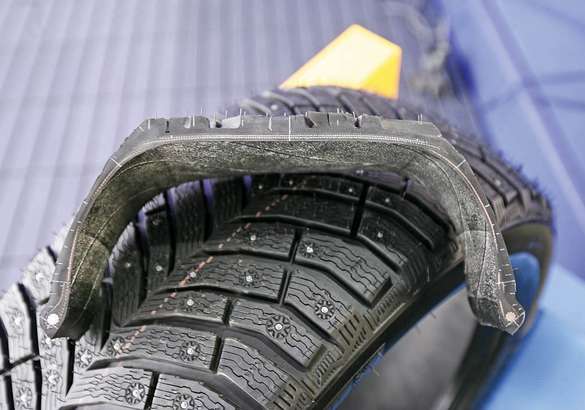
|
| Alaska |
North of 60°
Latitude - The use of studded tires is allowed between September 16th - April
30th.
South of 60° Latitude - The use of studded tires is allowed between October 1st - April 14th. |
| Arizona | The use of studded tires is allowed between October 1st - May 1st. |
| Arkansas | The use of studded tires is allowed between November 15th - April 15th. |
| California | The use of studded tires is allowed between November 1st - April 30th. |
| Colorado | The use of studded tires is not allowed |
| Connecticut |
The use of
studded tires is allowed between November 15th - April 30th.
|
| Delaware | The use of studded tires is allowed between October 15th - April 15th. |
| Florida | The use of studded tires is not allowed |
| Georgia | The use of studded tires is only allowed when safety requires them on slippery |
| Hawaii | The use of studded tires is not allowed. Exceptions: the Mauna Kea access road above Hale Pohaku and on all roads within the Mauna Kea Science. |
| Idaho | The use of studded tires is allowed between October 1st - April 30th. Exception: Fire departments. |
| Illinois |
The use of
studded tires is not allowed. Exceptions: Rural mail carriers and persons
with disabilities living in unincorporated areas are allowed to use studded
tires between November 15th - April 1st.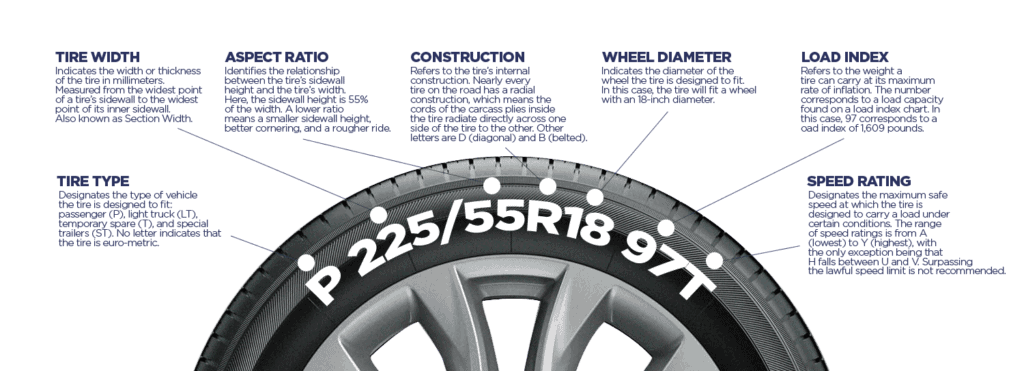
|
| Indiana | The use of studded tires is allowed between October 1st - May 1st. |
| Iowa | The use of studded tires is allowed between November 1st - April 1st. |
| Kansas | The use of studded tires is allowed between November 1st - April 1st. |
| Kentucky | The use of studded tires is allowed. |
| Louisiana | The use of studded tires is not allowed |
| Maine | The use of studded tires is allowed between October 2nd - April 30th. |
| Maryland |
The use of
studded tires is allowed between 1st - March 31st for vehicles registered in
the following counties only: Allegany, Carroll, Frederick, Garrett, and
Washington.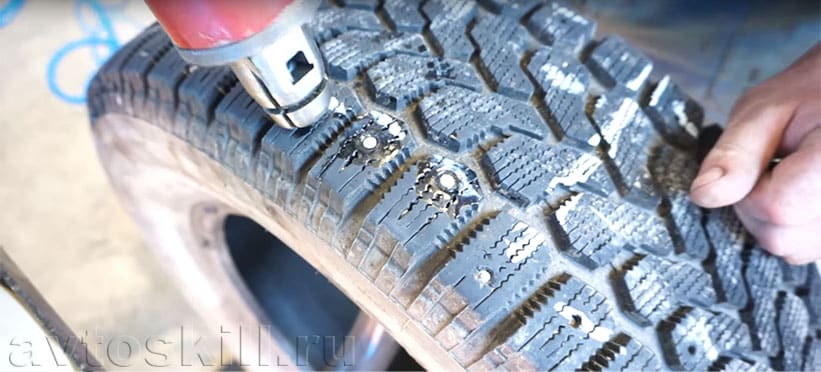
|
| Massachusetts | The use of studded tires is allowed between November 2nd - April 30th. |
| Michigan | The use of studded tires is not allowed. |
| Minnesota | The use of studded tires is not allowed. Exception: Rural mail carriers are allowed to use studded tires on certain road conditions between November 1st - April 15th. |
| Mississippi | The use of studded tires is not allowed. |
| Missouri | The use of studded tires is allowed between November 2nd - March 31st. |
| Montana | The use of studded tires is allowed between October 1st - May 31st. |
| Nebraska |
The use of
studded tires is allowed between November 1st - April 1st.
|
| Nevada | The use of studded tires is allowed between October 1st - April 30th. |
| New Hampshire | The use of studded tires is allowed. |
| New Jersey | The use of studded tires is allowed between November 15th - April 1st. |
| New Mexico | The use of studded tires is only allowed when safety requires them on slippery road surfaces. |
| New York | The use of studded tires is allowed between October 16th - April 30th. |
| North Carolina | The use of studded tires is allowed. |
| North Dakota |
The use of
studded tires is allowed between October 15th - April 15th. Exception: School
buses. Exception: School
buses.
|
| Ohio | The use of studded tires is allowed between from November 1st - April 15th. |
| Oklahoma | The use of studded tires is allowed between from November 1st - April 1st. |
| Oregon | The use of studded tires is allowed between from November 1st - March 31st. |
| Pennsylvania | The use of studded tires is allowed between from November 1st - April 15th. |
| Rhode Island | The use of studded tires is allowed between from November 15th - April 1st. |
| South Carolina | The use of studded tires is allowed |
| South Dakota |
The use of
studded tires is allowed between October 1st - April 30th. Exception: School
buses and municipal fire vehicles. Exception: School
buses and municipal fire vehicles.
|
| Tennessee | The use of studded tires is allowed between October 1st - April 15th. |
| Texas | The use of studded tires is not allowed. |
| Utah | The use of studded tires is allowed between October 15th - March 31st. |
| Vermont | The use of studded tires is allowed. |
| Virginia | The use of studded tires is allowed between October 15th - April 15th. |
| Washington | The use of studded tires is allowed between November 1st - March 31st. |
| West Virginia |
The use of
studded tires is allowed between November 1st - April 15
th, but only
on tires operating at 40psi or below.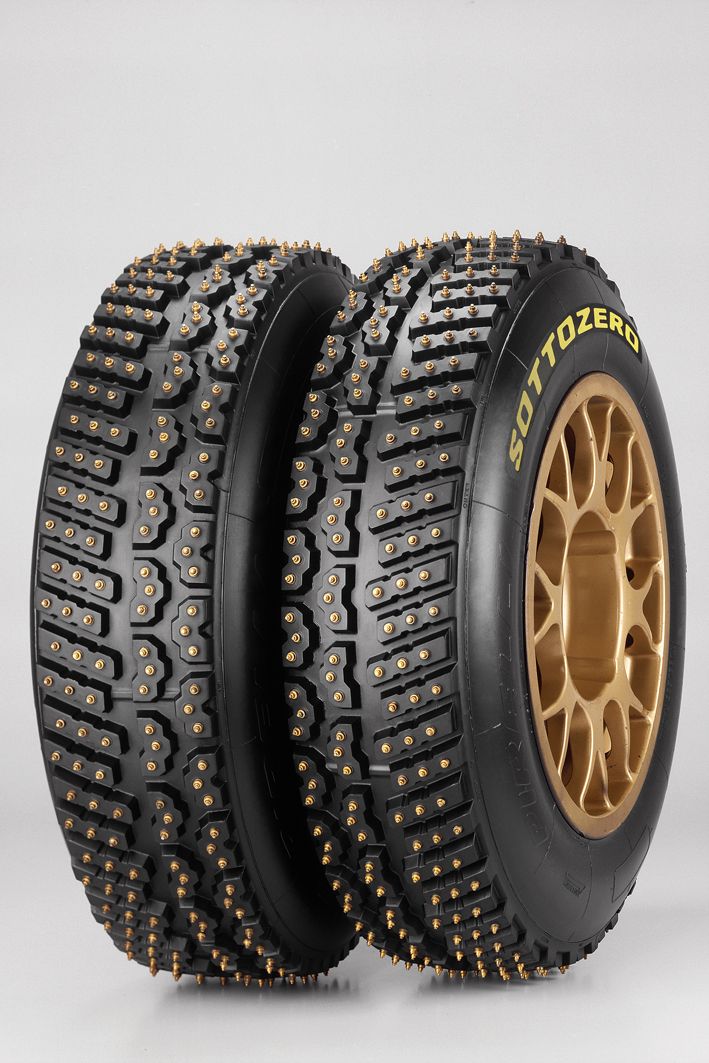
|
| Wisconsin | The use of studded tires is not allowed. Exception: Emergency vehicles, school buses, and mail delivery vehicles. |
| Wyoming | The use of studded tires is allowed. |
You need specific stud sizes for specific tires. After that, you can use a tire studding kit or a tire stud gun and tire lubricant.
The tire pins need to be lubricated in order for the tire studs to be inserted. You can use tire screws or a tire studding tool to add studs to the tread area. However, be careful. Studs need to be inserted correctly, or they will just cause additional problems. Yes, there is an answer to "how to stud tires correctly?".
Depending on their depth, studs can be inserted in the following ways:
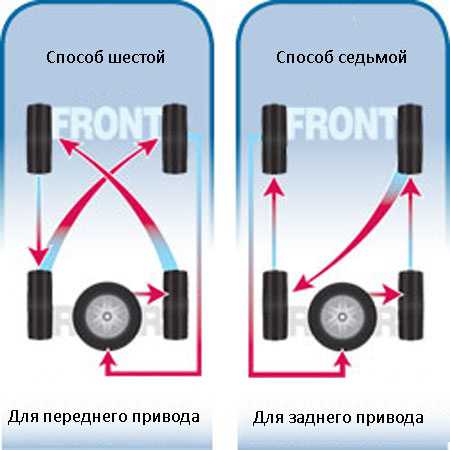
Additionally, tire studs should be inserted at 90-degrees. Anything more than a 10-degre difference will hinder the studded tires' winter performance.
Well, some studded winter tires are rated for over 100 mph. Yet, since they are made to be used on snow and ice, they should not be driven faster than 40 mph. This is because faster driving in deep snow and on icy roads can become dangerous. Additionally, these tires need a break-in period to safely perform.
Winter tires are designed to be used in below 45 degrees Fahrenheit.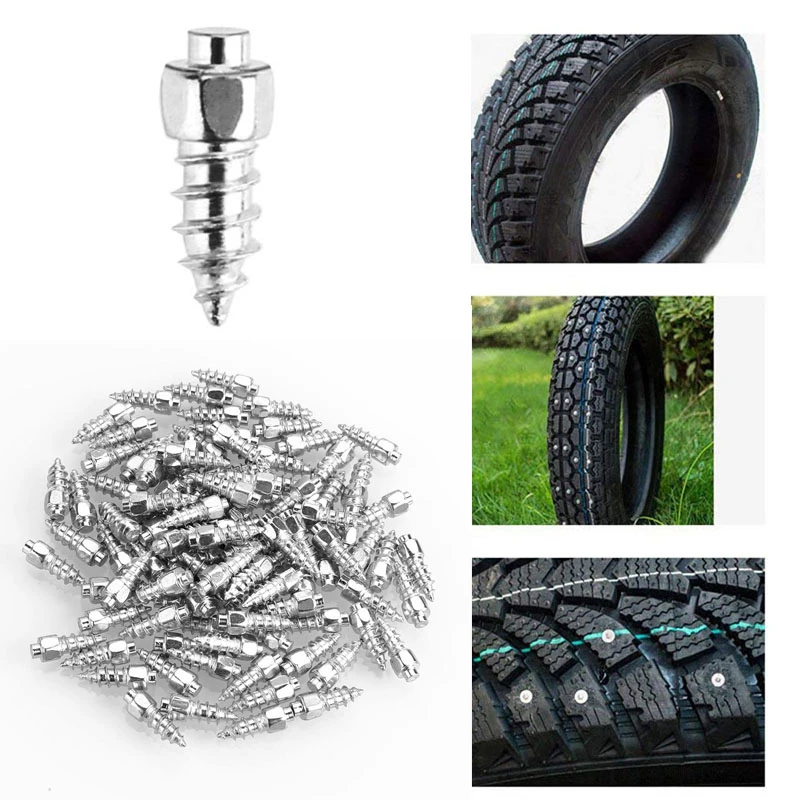 When temperatures drop below this, winter tires can be safely mounted and used on vehicles. Due to their special rubber compounds, winter tires should only be used in winter weather.
When temperatures drop below this, winter tires can be safely mounted and used on vehicles. Due to their special rubber compounds, winter tires should only be used in winter weather.
When you can use studded winter tires greatly depends on where you live. Some states without snow do not permit the use of studs at all or with some exceptions. Other states have specific dates when studded tires can be used on the vehicle. Check your state laws to know if you can use such tires or not.
Studded tires have no set life expectancy, as their performance depends on many factors. However, as long as the tires with winter tire studs are operated correctly (only on ice and packed snow-covered road surfaces), they will last for about 5 to 6 seasons.
4 comments
Contents:
Winter and summer driving. Realities
Realities
If you install new tires with studs
If you install used tires with studs
How to ride on studded tires
On the pages of the site from time to time the topic of "winter" and "summer" driving is touched upon, more precisely, the erroneous division of driving styles into winter and summer.
What is the difference between "winter" and "summer" driving style can be found in the articles Driving in winter. Maneuvering and The cold came - we change the style of driving.
The emphasis in the differences is that in summer, when it is warm and the car confidently clings to the road with all wheels, the driver can afford careless driving.
Sloppy in the sense that abrupt control methods are used: a sharp start, rough braking, a sharp change of lane, a sharp turn at speed and much more, where the movement of the car is accompanied by jerks.
In summer, such “numbers”, to put it mildly, pass without consequences, and such a driving style becomes a habit.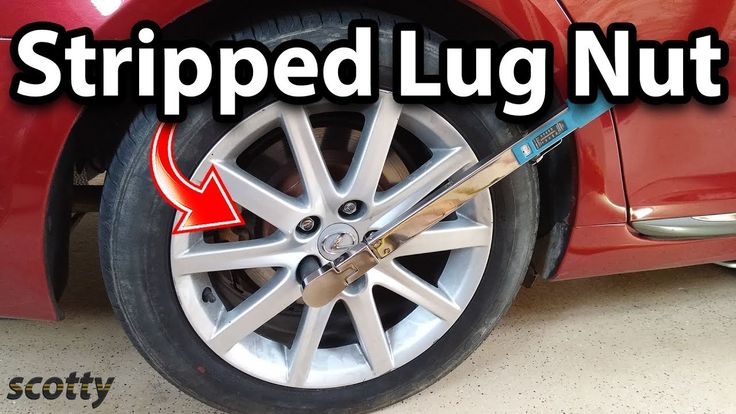 But in sub-zero temperatures, "summer" methods do not work.
But in sub-zero temperatures, "summer" methods do not work.
It is known that on a straight slippery road, even a slight jerk caused by careless driving can lead the car off the desired trajectory. The consequences can be very different.
See Beware of slippery roads and Winter driving for details. Maneuvering.
With the onset of cold weather, and the sudden appearance of ice formation on the road, many continue to drive, out of habit, in a rough summer manner.
An interesting fact is that the driver is aware of the need to switch to a "smooth" method of control, and tries with all his might to do so, but at the crucial moment this does not work.
The body unconsciously continues to work out of habit the way it has been doing all the time, i.e. as he is used to.
In order to adjust to the "winter" driving, the body needs time. And if the “perestroika” takes place, so to speak, on the border of heat and cold, then at this time many mistakes are made, often leading to an accident or a car breakdown.
How to act expediently is described in the article The cold has come - changing the style of driving.
This was a short introduction. Below we will consider some issues that relate to the operation of winter tires equipped with anti-skid studs.
You may be asking what is the connection between summer or winter driving habits and studded tires?
The connection is that summer driving style and winter road are incompatible things. Of course, you can combine them, but the result will be the same: either an accident will occur with another car, or the car will be off the road.
The same applies to the use of studded tyres. It will become clear later why this is so.
What do you need to know if your car's rims are fitted with winter tires equipped with anti-skid studs?
To begin with, new winter tires equipped with studs must be run in. What does it mean?
As the wheel rolls, the studs take up a certain position in the tire, i.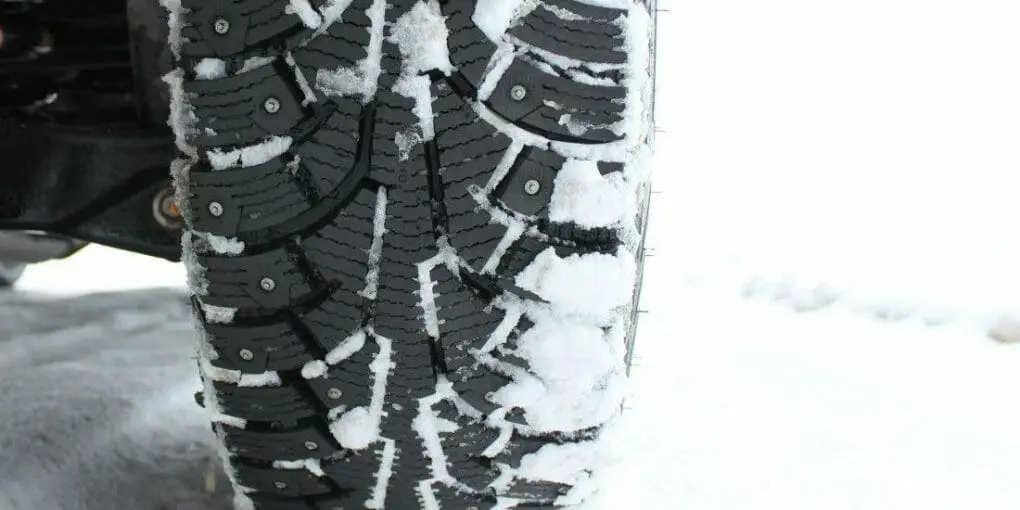 e. the spikes are run in, and are no longer strictly perpendicular to the surface of the tire, but slightly at an angle that is invisible to the eye, which is directed in the opposite direction to the rolling of the wheel.
e. the spikes are run in, and are no longer strictly perpendicular to the surface of the tire, but slightly at an angle that is invisible to the eye, which is directed in the opposite direction to the rolling of the wheel.
It takes several hundred kilometers to get the studs into such a stable position. Some experts say that 500 km is enough for this, others give a different figure - 1000 km. In general, the more the better.
In order not to argue, let's dwell on the fact that this distance should be at least 500 km, and even better - more than 1000 km. Moreover, during the running-in of winter studded tires, you should try to adhere to a calm driving style.
i.e. you need to try to prevent slipping of the wheels during the start, acceleration and braking. Otherwise, there is a risk of losing several spikes even in the process of their “burning in”, especially during slipping when starting back.
In the process of “breaking in the studs”, you should also not get carried away with high speeds when cornering.
If the geography of your trips does not go beyond the boundaries of the settlement, then it is difficult to drive 500 kilometers at a time, this takes time.
Therefore, it makes sense to change your shoes earlier and run winter tires in a quiet driving mode even before the onset of severe frosts in order to prevent slipping on ice at the run-in stage.
When you put studded wheels on your car that have already been in use, for example, you drove them last season, or bought used studded tires, then you need to install such tires in the direction of rotation of the wheel in the way they already rolled in past.
Otherwise, if you put the wheel on or change the tire in reverse, the studs will loosen and there is a risk of "losing" them. Not all, of course, something will remain, but such tires will no longer work properly on ice.
If the process of changing tires takes place in a tire shop, it is advisable to mark the direction of rotation of the used tire in advance, and tell the mechanic in which position it should be beaded onto the rim.
If you change the whole wheels, with disks, then the task is easier - it is enough to install them the way they rolled before.
Determining the direction of rotation of the wheel is not difficult. If the tread pattern is directional (on such tires, the rolling direction can be indicated by an arrow), then it is difficult to make a mistake, but it is possible, due to inattention.
If the tire tread is not directional (for example, "checkers" - such a wheel can be put back and forth), then carefully look at the spikes - note how worn they are.
It is almost impossible to notice the angle of inclination of the studs, but the working part of the studs, i.e. the ends themselves can tell you this - their more worn part will be on the side where the wheel rolled.
In general, in spring, when changing shoes from "winter" to "summer", it makes sense to mark tires with spikes the way the wheels were on the car, for example, left front, left rear, right front, right rear.
Next season you will need to install them the way they were this season. With proper maintenance, studded tires will last a long time.
What else do you need to know about using studded tires? It's about how to ride on studded tires.
Any car tires begin to "work" only after the rubber "warms up" and warms up.
The word "work" refers to grip. Under the same road conditions, "cold" tires cling to the road poorly, and more often skid, "warmed" tires have much better grip.
This feature must be taken into account, especially for those who rush to work by car in the morning.
In order to warm up the tires after a long, for example, overnight parking, you need to drive a couple of kilometers in a calm mode so that the frozen rubber warms up.
Studded tires are no exception. The colder (harder the frost), the longer it will take to stretch the tires. Then the wheels will roll softer, and it will be better to cling to the road surface.
Driving on studded tires has its own characteristics. It is best to start off on spikes, especially on the slopes of the road, “in tightness” so that the drive wheels do not slip.
When the drive wheels slip, the studs cut through the ice crust on the asphalt surface, and the efficiency of the studs is drastically reduced.
When driving on asphalt, the studs are not fully pressed into the rubber and thus reduce the traction of the wheels with the road.
At low speeds, this is almost not felt, on the contrary, it seems that studded wheels cling to the asphalt much better than without studs.
This happens due to the fact that the working part of the spikes has time to catch on the unevenness of the roadway.
As the speed increases, the grip deteriorates somewhat. For comparison, at a speed of 90 km/h on clean asphalt, the grip coefficient of studded tires is 10-15% lower than that of the same tires without studs.
The studded braking distance depends on a combination of road and technical factors.
Road conditions include the condition of the road: packed snow, clear ice, dry-looking asphalt, wet slush or something else, and the ambient temperature is also relevant here.
Technical factors include the presence of ABS on the vehicle, the health of the brake system, the speed at the moment, the manner of braking, i.e. here the human factor is already involved.
Different combinations of the above factors will result in different braking distances.
Numerous experiments have shown that the presence of studs does NOT make the braking distance shorter. Moreover, in some cases, the braking distance "on the spikes" may be longer than expected (when the ABS is working on a slippery road).
Braking on slippery winter roads should be done very smoothly, without allowing the wheels to lock. If you need to brake hard, but your car is not equipped with ABS, then it is advisable to use fast intermittent braking.
This technique will help if you need to both brake and steer, regardless of whether the tires have studs or not.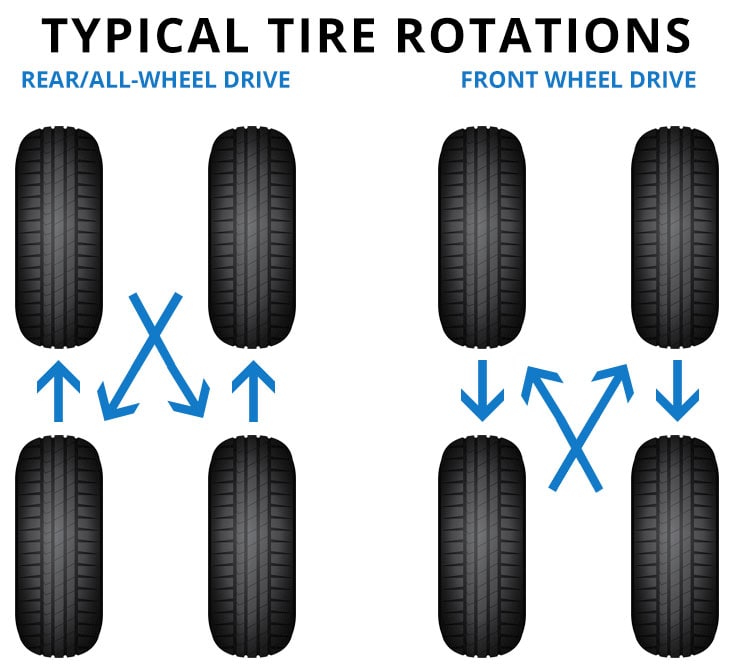 It is discussed in the article Why brakes need an ABS system.
It is discussed in the article Why brakes need an ABS system.
That's all the bare minimum of how to ride on studded tires so that your movement is relatively comfortable and the tires last a long time.
Stay on the site pages. You will find a lot of interesting and useful things in terms of your own safety on the roads.
You can ask your question in the comment form, which is located at the very end of the text "feed".
In continuation of the topic “how to ride on studded tires” and answers to questions about ensuring your own safety on the road, I suggest that you read the material of the following articles:
Slipped;
Caution, slippery road;
It's time to "change shoes";
How not to "fly away" from a slippery road;
The cold has come - we are changing the driving style;
Driving a car in winter. Maneuvering.
Be careful while driving.
Author: Sergey Dovzhenko
If you want to share what you have read, click on the button below to choose from.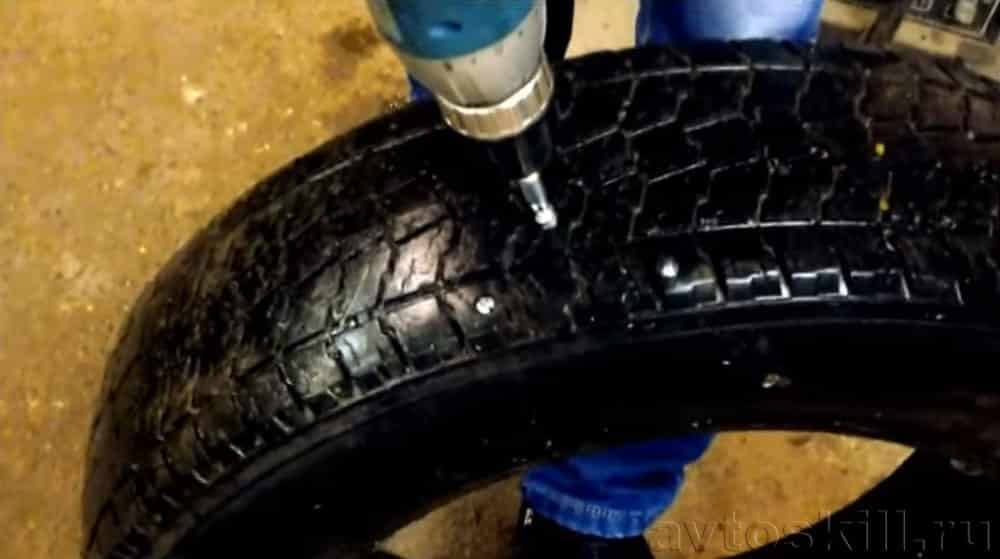 We press, do not be shy.
We press, do not be shy.
|
Everyone knows how dangerous summer tires are when driving on a winter road. Driving with summer tires in winter is extremely undesirable and dangerous due to the hardness of the tire and insufficient tread depth. And what about driving a car in the summer on winter tires? There is a common misconception among owners of Velcro winter tires that it is not necessary to change tires if they are not bald. Velcro will not stick to the road surface. But it's not. Even careful driving at close range has a number of negative consequences: high risk of danger in an emergency, heavy wear and tear, difficulty driving. The main differences between winter tires are the properties of the rubber, tread pattern and groove depth. All these qualities provide reliable grip with minimal rolling resistance. The main negative consequences of using winter tires in summer: • Rapid wear. • Steering difficulties. Even a moderate temperature of 11 degrees Celsius has a critical effect on the car on the road: steering is difficult, maneuvers on the road lead to wobbling, poor acceleration when revving. If you do not change the tires, just a few trips will put the rubber out of action. • Long stopping distance. Driving with winter tires is more dangerous than bald summer tires in summer. Insufficient traction with the roadway leads to an increase in braking distance, which can increase up to two lengths of the car body. • Increased fuel consumption. In order for the grip to occur, the winter tire needs more effort. Additional effort comes from the operation of the engine, which requires more fuel. Statistics show that riding on Velcro tires on a hot day increases gas mileage by 5-10%. If you calculate how much additional fuel you have to fill in, saving on reluctance to change a set of tires looks doubtful. Studded tires complete the list of unpleasant consequences: • Riding on studded tires can cause dangerous studs to fly out. • Noise on dry pavement will deprive the ride of any comfort. • Damage to the road surface. In summer, spikes from tires practically cut out part of the asphalt, and a rut forms on the road. And yet, is it worth driving a winter tire in the summer? Misuse of winter tires leads to a number of harmful consequences for the car and the driver: a high risk of accidents on the roads, difficulties with driving, rapid wear and failure of a number of car systems, increased fuel consumption and, finally, a fine. The question of why it is necessary to change winter tires for summer tires has a definite answer - such trips on asphalt in the hot season will not bring anything good. However, much depends on where the car is operated and in what climatic conditions. On roads in the northern latitudes, in the "permafrost" zone, it is worth adhering to common sense and the rules established for a particular region. From a legal point of view Driving with winter tires is not the end of a car problem. Efforts are constantly being made to introduce specific regulations and penalties for the use of winter tires in the summer. In 2014, the Technical Regulations of the Customs Union were signed, according to which, from 2015, a driver who uses a car with winter tires in the summer will be fined. TR TS 018/2011 "On the safety of wheeled vehicles" in addition to the restriction on the operation of bald tires, introduces prohibitions regarding the rules for the operation of tires on the roads: • The ban applies only to vehicles equipped with tires with anti-skid studs. • A fine will be issued if studded tires are used between June and August, ie. only during the calendar summer months this cannot be done. At the same time, there is no legislative indication of which tires to drive in the autumn and spring and when a set change is required. However, there is a provision that the rules for the operation of seasonal tires can be determined taking into account the climatic and weather conditions of a particular region. For example, in areas of northern latitudes, summer tires are not required at all. • Tread depth requirement prohibiting the use of bald tires. For the summer kit, tires with a depth of less than 1.6 mm cannot be used. For the winter kit, the tread depth should be from 4 mm. |